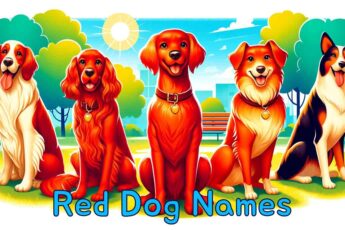Throughout American history, presidential pets have captured the public’s imagination, offering a unique glimpse into the personal lives of the nation’s leaders. Dogs, in particular, have been constant companions to many U.S. presidents, often becoming celebrities in their own right.
These four-legged residents of 1600 Pennsylvania Avenue have played various roles, from loyal friends and stress relievers to public relations assets and, occasionally, sources of controversy.
From Franklin D. Roosevelt’s Scottish Terrier, Fala, who became a national icon during World War II, to the more recent German Shepherds of the Biden administration, these canine occupants of the White House have left an indelible mark on the American presidency. They’ve been present during moments of national crisis, featured in campaign speeches, starred in Christmas videos, and even “authored” books.
The stories of these presidential pooches reflect not just the personalities of the First Families but also the changing times and values of American society. Whether it’s Nixon’s famous “Checkers speech,” the Bush family’s literary-inclined spaniel Millie, or the Obamas’ hypoallergenic Portuguese Water Dogs, each presidential pet has contributed to the narrative of their era in Washington.
This exploration of White House canines reveals tales of loyalty, humor, and occasional mischief. It also highlights how these animals have helped to humanize presidents, bridge political divides, and sometimes even influence public opinion.
From the earliest days of the republic to the present, dogs have been a constant presence in the Executive Mansion, providing companionship, comfort, and a touch of normalcy to the extraordinary lives of America’s leaders.
List of The Most Famous Dogs of U.S. Presidents:
- Fala – Franklin D. Roosevelt’s Scottish Terrier
- Checkers – Richard Nixon’s Cocker Spaniel
- Buddy – Bill Clinton’s Labrador Retriever
- Millie – George H.W. Bush’s English Springer Spaniel
- Bo and Sunny – Barack Obama’s Portuguese Water Dogs
- Sully – George H.W. Bush’s service dog (after his presidency)
- Barney and Miss Beazley – George W. Bush’s Scottish Terriers
- Him and Her – Lyndon B. Johnson’s beagles
- Major and Champ – Joe Biden’s German Shepherds
- Liberty – Gerald Ford’s Golden Retriever
Fala – The Little Dog in the Big White House
Franklin Delano Roosevelt’s Scottish Terrier, Fala, became one of the most famous presidential pets in American history. Born on April 7, 1940, Fala was given to President Roosevelt as a Christmas gift by his cousin Margaret “Daisy” Suckley.
The little black Scottie quickly became Roosevelt’s constant companion, accompanying the president everywhere, from crucial White House meetings to international conferences. Fala’s charming presence often lightened the mood during the dark days of World War II, providing comfort not only to the president but also to a nation in turmoil.
Fala’s fame grew to such an extent that he received thousands of letters from citizens across the country. The president’s staff appointed a secretary to handle Fala’s voluminous correspondence, a testament to the dog’s popularity and the public’s affection for him.
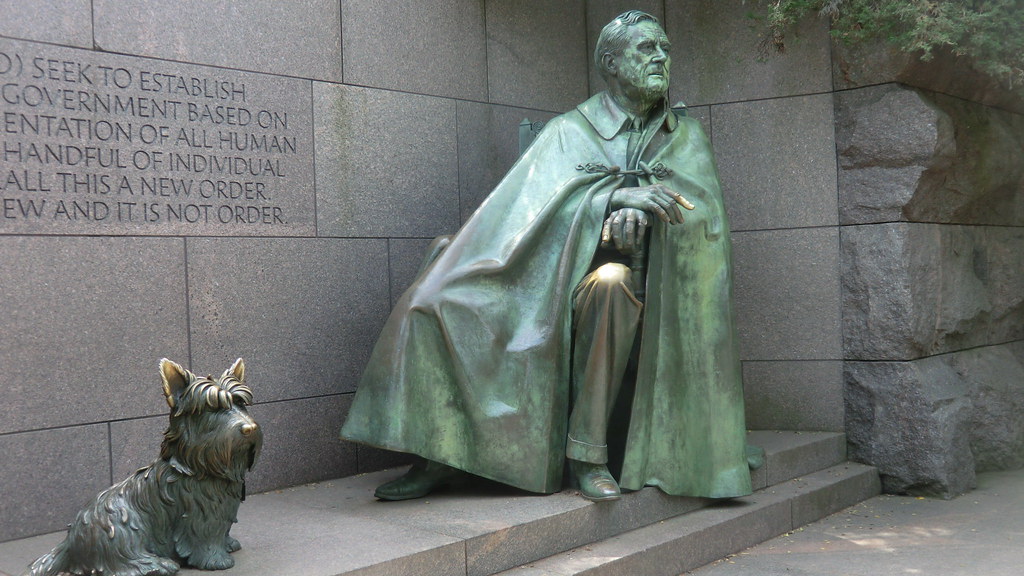
Perhaps Fala’s most notable moment in the spotlight came during the 1944 presidential campaign. Republicans accused Roosevelt of accidentally leaving Fala behind on the Aleutian Islands and sending a Navy destroyer to retrieve him at great taxpayer expense. Roosevelt brilliantly deflected this criticism in his famous “Fala speech,” using humor to mock his opponents and effectively neutralizing their attacks.
After Roosevelt died in 1945, Fala lived with the former First Lady, Eleanor Roosevelt. He passed away on April 5, 1952, just shy of his twelfth birthday, and was buried near Franklin Roosevelt’s grave at the Roosevelt estate in Hyde Park, New York.
Fala’s legacy as “the most famous dog in the world” during his time continues to captivate the public imagination. His statue stands alongside Roosevelt’s at the Franklin Delano Roosevelt Memorial in Washington, D.C., eternally symbolizing the bond between a president and his faithful canine companion.
Checkers: The Dog That Saved Nixon’s Career
Richard Nixon’s Cocker Spaniel, Checkers, played a pivotal role in American political history despite never actually living in the White House. In 1952, Nixon was a young Senator and the Republican vice presidential candidate when he faced accusations of impropriety regarding a fund established by his backers to reimburse him for political expenses.
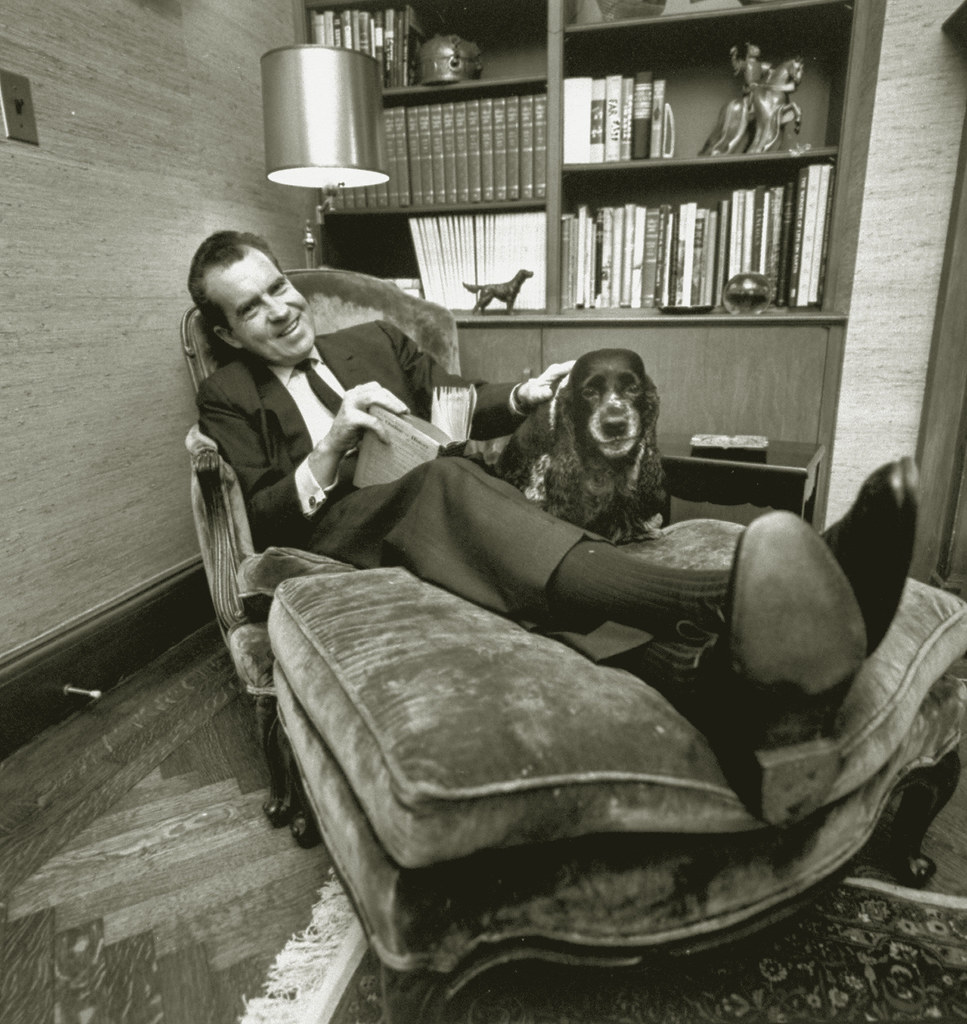
Under pressure to resign from the ticket, Nixon decided to address the nation directly in a televised speech. During this address, which became known as the “Checkers speech,” Nixon denied any wrongdoing and appealed to the public’s emotions by mentioning a gift his family had received and refused to give back: a black-and-white Cocker Spaniel named Checkers.
Nixon’s words about Checkers struck a chord with the American public:
“A man down in Texas heard Pat on the radio mention that our two youngsters would like to have a dog, and, believe it or not, the day before we left on this campaign trip, we got a message from Union Station in Baltimore, saying they had a package for us. We went down to get it. You know what it was?
It was a little cocker spaniel dog in a crate that he’d sent all the way from Texas, black and white, spotted, and our little girl Tricia, the six-year-old, named it Checkers. And you know, the kids, like all kids, love the dog, and I just want to say this, right now, that regardless of what they say about it, we’re going to keep it.”
This personal anecdote humanized Nixon and garnered widespread public support. The speech was a resounding success, saving Nixon’s place on the ticket and possibly his political career. Although Checkers passed away in 1964, long before Nixon became president in 1969, the dog’s impact on American politics was significant and long-lasting.
The term “Checkers speech” has since become political shorthand for an emotional appeal designed to gain public sympathy, illustrating how a simple family pet can become an important figure in national politics.
Buddy: Clinton’s Loyal Labrador
Buddy, a chocolate Labrador Retriever, joined the Clinton family in the White House in December 1997. The energetic pup was named after Bill Clinton’s great-uncle Henry Oren “Buddy” Grisham, who had passed away earlier that year.
Buddy quickly became a beloved member of the First Family and a familiar sight on the White House grounds. He often accompanied President Clinton on walks, providing a welcome distraction during some of the most tumultuous years of his presidency.
The friendly Labrador comforted Clinton during the impeachment proceedings in 1998 and 1999. In fact, Clinton once remarked, “I think it’s the President who really needs him,” highlighting the emotional support Buddy provided during difficult times.
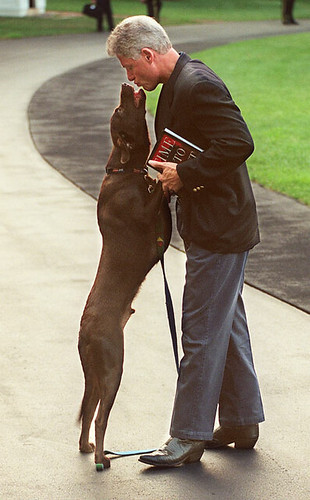
Buddy’s relationship with the Clinton family cat, Socks, was famously rocky. Their rivalry was so well-known that Clinton joked about it in his 2000 White House Correspondents’ Dinner speech, saying, “I’ve been working on this a long time, and I’m trying to get Buddy and Socks to be friends, but I don’t have enough time.”
After leaving the White House in 2001, Buddy moved with the Clintons to their home in Chappaqua, New York. Tragically, Buddy’s life was cut short in January 2002 when he was struck by a car while chasing a contractor who had left the Clinton property.
Despite his relatively short time in the public eye, Buddy left a lasting impression on many Americans. He symbolized the comforting presence of a loyal pet during times of personal and political turmoil, reminding the public of the more relatable aspects of presidential life.
Millie: The Literary First Dog
Millie, an English Springer Spaniel, belonged to President George H.W. Bush and First Lady Barbara Bush. She became one of the most famous presidential pets in history, not just for her time in the White House but also for her “literary” achievements.
Born in 1985, Millie moved into the White House with the Bushes in 1989. She quickly became a beloved figure, often seen romping on the White House lawn or accompanying the President and First Lady on walks.
Millie’s claim to fame came in 1990 when she “authored” a book titled “Millie’s Book: As Dictated to Barbara Bush.” This clever and humorous book, written from Millie’s perspective, offered an insider’s view of a day in the White House. It included anecdotes about the president’s daily routine, described meetings with world leaders, and shared Millie’s thoughts on White House life.
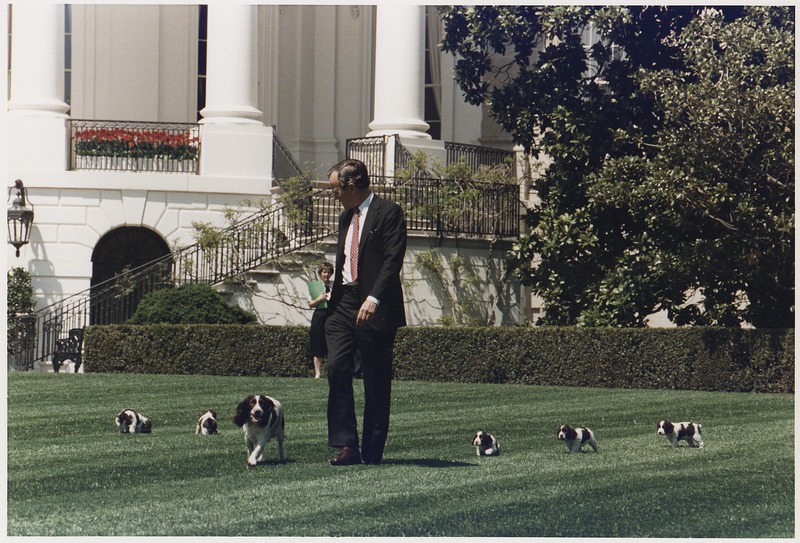
The book was a bestseller and raised over $1 million for literacy causes, a passion of First Lady Barbara Bush. This literary success made Millie arguably more famous than many human occupants of the White House.
In 1991, Millie gave birth to a litter of puppies, some of which were given to family and friends. One of these puppies, Spot, would later return to the White House as President George W. Bush’s pet.
Millie’s popularity was such that she was often mentioned in President Bush’s speeches. In fact, Bush once famously quipped, “My dog Millie knows more about foreign affairs than these two bozos,” referring to his opponents in the 1992 presidential campaign.
Millie passed away in 1997, but her legacy lived on. She remains one of the most remembered and beloved presidential pets, known not just for her time in the White House but for her unique contribution to literacy efforts and her “insider’s perspective” on presidential life.
Bo and Sunny: The Portuguese Water Dogs of the Obama White House
When Barack Obama was elected president in 2008, he promised his daughters, Malia and Sasha, that they could get a dog. This promise led to the arrival of Bo, a male Portuguese Water Dog, in April 2009.
Bo was a gift from Senator Ted Kennedy, who owned several dogs of the same breed. The Obamas chose this breed partly because it was hypoallergenic, which was important for Malia’s allergies. The Obama daughters chose Bo’s name, reportedly inspired by their cousin’s cat named Bo and in reference to musician Bo Diddley.
Bo quickly became a beloved member of the First Family and a popular figure in the media. He was often seen playing on the White House lawn, accompanying the president in the Oval Office, or greeting visitors on tours. Bo even had the important job of visiting wounded veterans and children in hospitals, bringing cheer to those in need.
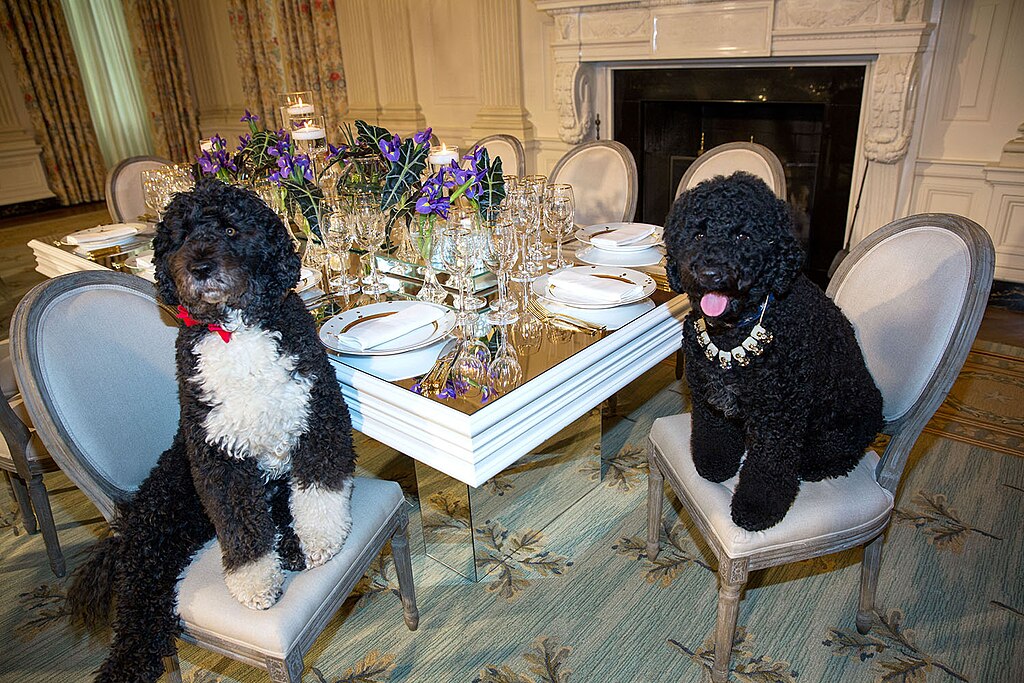
In August 2013, the Obamas added another Portuguese Water Dog to their family: Sunny, a female. Named for her cheerful disposition, Sunny was brought in as a companion for Bo and to provide more energy in the house as the Obama daughters grew into teenagers.
Together, Bo and Sunny became known as the “First Dogs,” capturing the hearts of the American public. They were featured in numerous White House photos and videos, participated in the annual Easter Egg Roll, and even “wrote” a book together called “Bo, America’s Commander in Leash.”
The dogs were also used to promote various initiatives. For instance, they appeared in public service announcements about emergency preparedness and were part of the First Lady’s “Let’s Move!” campaign to fight childhood obesity.
Bo and Sunny’s presence in the White House highlighted the Obamas’ normalcy and family-oriented nature, helping to humanize the presidency and connect with the American public on a personal level.
After leaving the White House, Bo and Sunny continued to be part of the Obama family. Sadly, Bo passed away in May 2021 after battling cancer, leading to an outpouring of condolences from around the world. Sunny continues to be a cherished member of the Obama family.
Sully: The Loyal Service Dog of George H.W. Bush
Sully, a yellow Labrador Retriever, entered former President George H.W. Bush’s life in June 2018, several months after the passing of former First Lady Barbara Bush. Unlike the other dogs on our list, Sully served Bush during the last months of his life after his presidency.
Named after Chesley “Sully” Sullenberger, the pilot who safely landed a passenger plane on the Hudson River in 2009, Sully was trained by America’s VetDogs. This organization provides service dogs to veterans and first responders with disabilities.
As a service dog, Sully was capable of performing a two-page list of commands, including answering the phone and fetching items. He provided assistance and companionship to the 94-year-old former president, who used a wheelchair and had Parkinson’s disease.
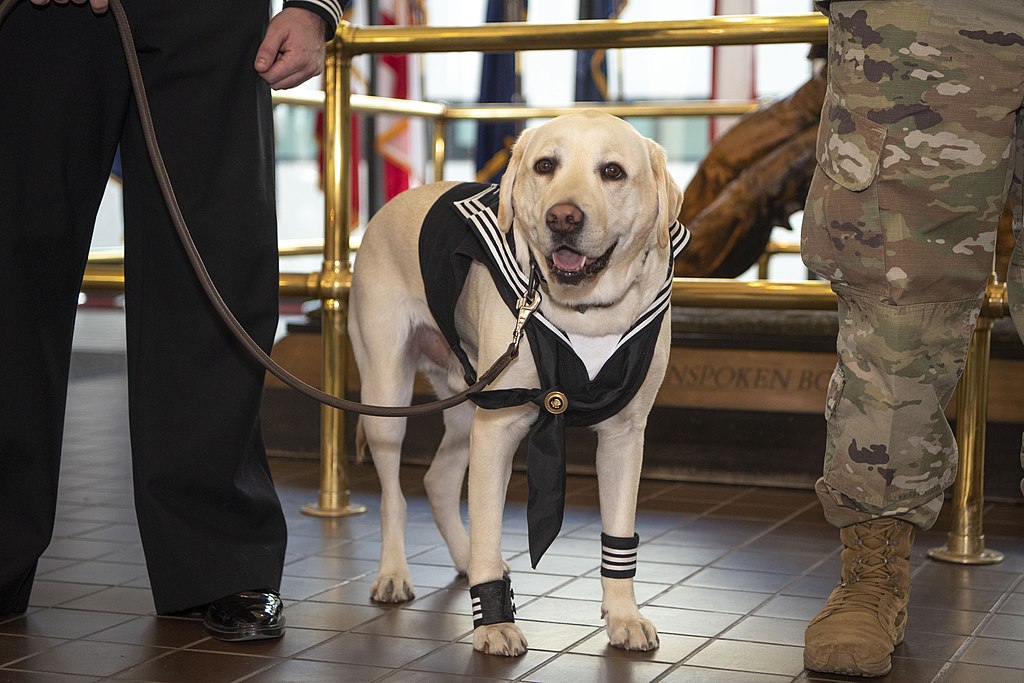
Despite their short time together, Sully and Bush formed a strong bond. The dog’s devotion captured the nation’s heart, especially after Bush’s passing in November 2018. A photo of Sully lying in front of Bush’s flag-draped casket, with the caption “Mission complete,” went viral and became a poignant symbol of loyalty and service.
After Bush’s death, Sully’s work was not over. He was reassigned to Walter Reed National Military Medical Center in Bethesda, Maryland, where he continues to serve by assisting wounded veterans and active duty service members during their recovery.
In recognition of his service, a statue of Sully was unveiled in December 2020 at Bush’s presidential library in College Station, Texas. The life-size bronze statue depicts Sully in a sitting position holding his leash in his mouth, representing loyalty and service.
Sully’s story highlights not only the deep bond between humans and dogs but also the vital role that service animals play in enhancing the lives of those with disabilities. His brief but impactful time with President Bush brought attention to the importance of programs that train and provide service dogs to those in need.
Barney and Miss Beazley: The Scottish Terriers of the George W. Bush White House
Barney and Miss Beazley, both Scottish Terriers, were the beloved pets of President George W. Bush and First Lady Laura Bush during their time in the White House.
Barney, born in 2000, was the first to join the Bush family. He moved into the White House in 2001 when George W. Bush became president. Known for his playful and sometimes mischievous nature, Barney quickly became a favorite among White House staff and visitors.
In 2004, Miss Beazley joined the family as a birthday gift from President Bush to First Lady Laura Bush. Named after a character in Oliver Jeffers’ children’s book “Don’t Eat the Teacher,” Miss Beazley was actually Barney’s niece.
The two Scottish Terriers became stars in their own right during the Bush administration. They were featured in annual White House Christmas videos, which became known as the “Barney Cam.” These popular videos showed White House holiday preparations from the dogs’ perspective and often included cameos from administration officials and the president himself.
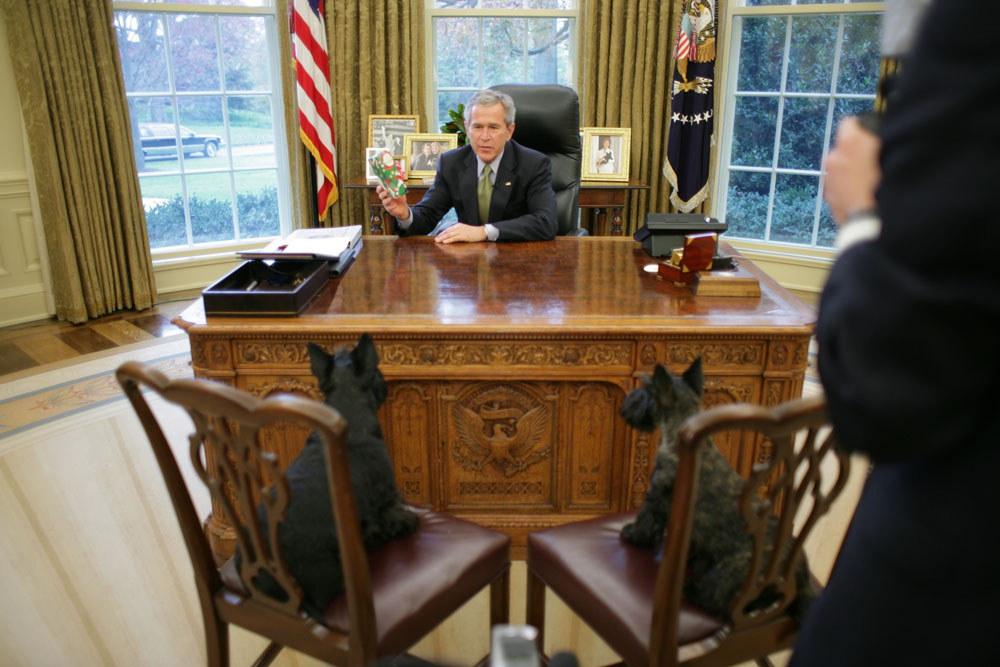
Barney, in particular, gained fame for his occasional strong-willed behavior. In one notable incident in 2008, he bit a Reuters reporter’s finger when the journalist tried to pet him. President Bush later joked about the incident, saying, “I think it was precedent-setting. I think the press will be a little more circumspect when it comes to petting the president’s dog.”
Both dogs were also known for their interactions with foreign dignitaries. Russian President Vladimir Putin once compared the size of his hound to that of Barney, to which President Bush later retorted, “Barney had seen a lot of leaders, but Putin was the only one who caused him to sob.”
After leaving the White House, Barney and Miss Beazley retired to Texas with the Bush family. Barney passed away in 2013 at the age of 12, followed by Miss Beazley in 2014 at the age of 9. Their deaths were mourned not just by the Bush family but by many Americans who had come to know and love the presidential pups through their White House antics.
The Scottish Terriers left a lasting legacy. Their Barney Cam videos, still available online, provide a unique and endearing glimpse into life at the White House during the Bush administration.
Him and Her: Lyndon B. Johnson’s Controversial Beagles
Lyndon B. Johnson, the 36th President of the United States, was known for his love of dogs. Among his most famous canine companions were a pair of beagles simply named “Him” and “Her.”
Him and Her came to the White House in 1963, shortly after Johnson assumed the presidency following John F. Kennedy’s assassination. The beagles quickly became a familiar sight on the White House grounds and in the Oval Office.
Johnson was often photographed with the dogs, and he frequently used them in his interactions with the press and politicians. He would sometimes use the beagles as a distraction when he wanted to change the subject during press conferences or meetings.
However, the most infamous incident involving Him and Her occurred in April 1964, which sparked controversy and public outrage. During a meeting on the White House lawn, President Johnson picked up one of the dogs by the ears. When the photo of this action was published, it led to an immediate backlash from animal lovers and dog owners across the nation.
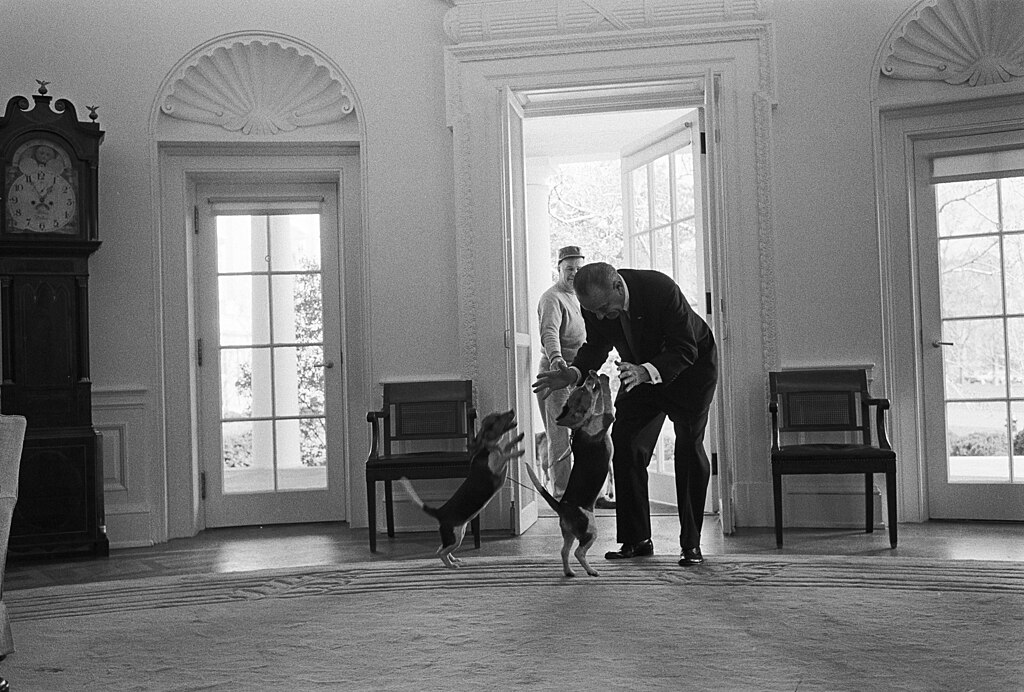
The President defended his actions, stating, “I’ve been pulling beagles up by the ears for years. And they love it. They’re hanging, their mouth is open, and their tongue is hanging out.” Despite his explanation, the incident damaged Johnson’s public image and led to criticism from animal rights organizations.
Sadly, the story of Him and Her had a tragic end. In 1964, Her died after swallowing a stone on the White House lawn. Him lived until 1966, when he was hit by a car while chasing a squirrel on the White House grounds.
Despite the controversy and their untimely deaths, Him and Her left a lasting impression on the American public. They highlighted both the joys and responsibilities of pet ownership, even in the highest office of the land. Their story also serves as a reminder of how presidential pets can impact public perception and even influence political discourse.
Major and Champ: The German Shepherds of the Biden White House
When Joe Biden assumed the presidency in January 2021, he brought with him two German Shepherds: Major and Champ. These dogs marked the return of pets to the White House after a four-year absence during the Trump administration.
Champ, the older of the two, was born in 2008 and has been with the Bidens since Joe Biden was Vice President. Biden’s grandchildren chose his name, which holds special significance for the President, who recalled that his father used to tell him, “Any time you get knocked down, champ, get up!”
Major, on the other hand, made history as the first rescue dog to live in the White House. After fostering him, the Bidens adopted Major from the Delaware Humane Association in 2018. Major’s adoption highlighted the Bidens’ support for animal rescue organizations and adoption.
The dogs’ transition to White House life wasn’t without incident. In March 2021, Major was involved in two separate biting incidents with White House staff. This led to additional training for Major and a brief return to Delaware for both dogs.
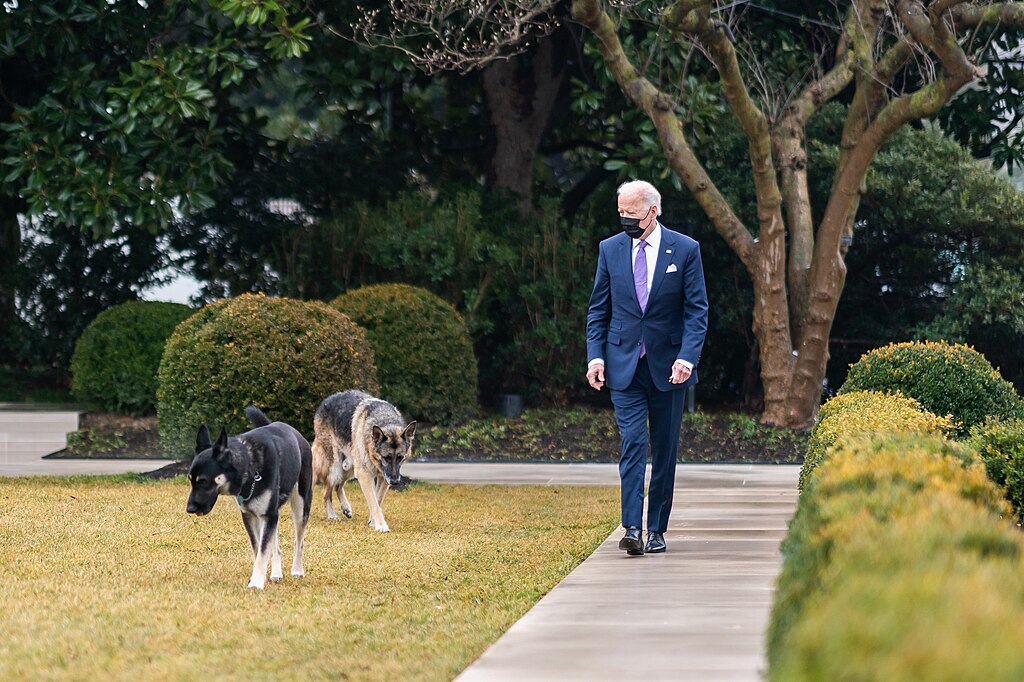
The incidents sparked discussions about the challenges of adapting rescue animals to new environments and the stress that high-profile settings like the White House can place on pets.
Sadly, Champ passed away in June 2021 at the age of 13. The Bidens released a statement honoring their “constant, cherished companion” who had been with the family through both joyful and sorrowful times.
Following Champ’s passing and Major’s adjustment issues, the Bidens welcomed a new puppy, another German Shepherd named Commander, in December 2021. They also added a cat named Willow to their White House family in January 2022.
Major ultimately transitioned to living with family and friends in a quieter environment, where he could receive more individualized care and training.
The story of Major and Champ (and later Commander) highlights the ongoing tradition of presidential pets, the joys and challenges of pet ownership, and the Bidens’ commitment to animal welfare. Their presence in the White House has helped to humanize the First Family and has brought attention to issues such as animal adoption and responsible pet ownership.
Liberty: Gerald Ford’s Golden Retriever
Liberty, a female Golden Retriever, became a beloved member of the Ford family during Gerald Ford’s presidency from 1974 to 1977. In 1974, she was a gift to the president from his daughter Susan and his personal photographer, David Hume Kennerly.
Susan Ford chose the name “Liberty” based on numerous suggestions from the public. It was a fitting name for a presidential dog during the United States bicentennial year and reflected the spirit of the times following the Watergate scandal.
Liberty quickly became a fixture in the White House and was often seen accompanying President Ford. She was known for her friendly demeanor and became a comforting presence for the president during his term. Ford was frequently photographed playing with Liberty on the White House lawn or in the Oval Office, which helped to soften his public image.
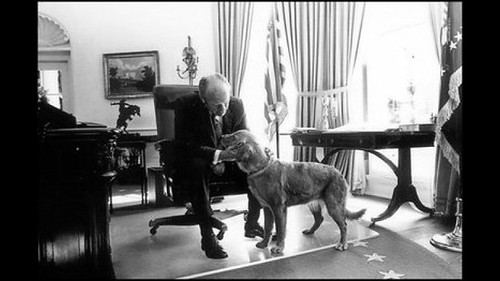
One of Liberty’s most notable moments came on September 16, 1975, when she gave birth to a litter of puppies in the White House. The event garnered significant media attention, with one of the puppies, named Misty, staying with the Fords while the others were given to loving homes.
Liberty also played a role in Ford’s public life. In a famous incident, Ford used Liberty to avoid answering reporters’ questions about his choice for a running mate in the 1976 election. As journalists pressed him for an answer, Ford pointed to Liberty and said, “I think she’s the only one who knows, and she’s not talking.”
After leaving the White House, Liberty moved with the Fords to their home in California. She remained an important part of the family until her passing in 1984 at the age of 11.
Liberty’s presence in the White House helped to humanize President Ford and provided a sense of normalcy and warmth during a tumultuous time in American politics. Her legacy as a presidential pet continues to be remembered fondly by many Americans.








